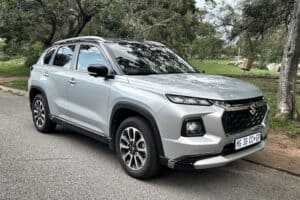It is easy to drive, with light steering, excellent control feel and a reasonably good ride.

Estate agents are the champions of euphemistic language.
So a “fixer upper” is probably a crumbling mess of a house; “urban buzz” probably means it sits right next to the N1 highway and “quirky” means it was designed by a deranged artist.

,
One of the favourites popping up in house ads is: “Starting up or slowing down”.
This, supposedly, shows the type of property which can appeal to both newly married just setting out on life together or to those “empty nesters” who no longer have the burden of offspring.
In reality, it just means small (sometimes tiny) and cheap.
However, I must admit the estate agents are accurate in summing up two different lifestyle stages … and their insight about property applies equally to the car market.
That is why the bottom end of the long list of new cars in this country has appeal to all the “starting up and slowing down” set. And there are similar requirements for both.

,
For a young couple, or a family, the first priority is reliable transport.
It must not only be cheap to buy, it must also be cheap to run, in terms of both fuel costs and repairs and maintenance.
Yet, these days, it must also have a decent level of equipment – both for safety and for comfort and convenience.
Older couples – or even those still working but who are getting hammered by the cost-of-living and of running cars – can also find “buying down” either necessary or appealing.
Whatever the reason for going cheaper (and smaller), these type of buyers will also want something which is well-equipped from a safety point of view as well as packing the little luxuries which are difficult to give up.
However, nothing is cheap these days, so “entry level” has, effectively, come to mean any car which comes in at under the R200 000 level.
And, that sector is one of the fastest-growing in the country at the moment, in terms of numbers of models available and numbers of units sold.

.
Over the next few weeks, I will be taking a look at some of these base – but by no means basic models – and laying out for you the good and bad points.
Firstly, let me be slightly controversial: Apart from models like the Datsun Go, Renault Kwid and a few Chinese imports at the very bottom end, there are no bad small car options on the market at the moment.
The first car under the microscope is Suzuki’s Swift, which comes in two variants, at R160 900 and R177 900 respectively.
The Swift is powered by a 1.2 litre petrol engine, which produces 61kW.
This sounds a bit anaemic – and at our Highveld altitudes you do have to rev it a bit and stir the five-speed manual gearbox to get it going (an auto is also an option) – but it actually revs very nicely and gives the lightweight Swift a decent turn of performance.
Being a Suzuki, the first thing you will want to complain about is the broken fuel gauge needle. It won’t be … but the cars are so frugal (we got around 5 litres per 100km easily on the highway and under 7l/100km in the city) that you will think there’s a fault.
Being a Japanese-designed car (although it is made in India today), the Swift is easy to drive, with light steering, excellent control feel and a reasonably good ride, considering the class and the fact the car has a short wheelbase.
Although the 1.2 doesn’t have the power that its previous sibling, the 1.6 Sport, did, it still feels sharp and athletic and is a rewarding driver’s car.
That is one of the surprises of the Swift: that the driving experience is still so good, despite the price and entry level nature of the car.
That’s because Suzuki has been building excellent small cars for years and has a wealth of sports experience (albeit through its bike division).
Downside of the Swift is that it is small.
The new model is slightly bigger in some dimensions than the outgoing one, but it is still quite tight in the back row of seats for tall people.
And the boot is really small.
Mind you, the back seats tumble forward, so if there are only two of you, you can take a decent amount of luggage if you’re going away on holiday.
And that is something I wouldn’t hesitate to do in the Swift, its size notwithstanding.
If you are starting up or slowing down, then the Swift has to be on your shopping list.
Drive one and you’ll see what I mean.
Positives:
- Value for money
- Suzuki’s bullet-proof reputation for reliability
- Pretty decent equipment levels
- Great fuel economy
- Rewarding drive experience
Negatives:
- It’s small
- Err
For more news your way, download The Citizen’s app for iOS and Android.







